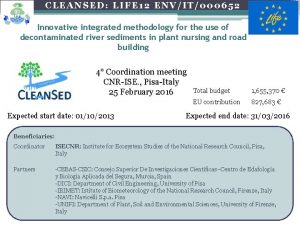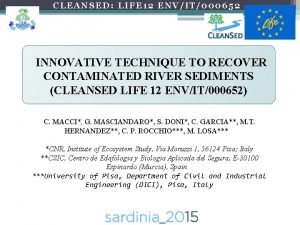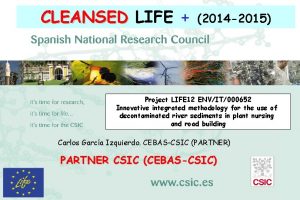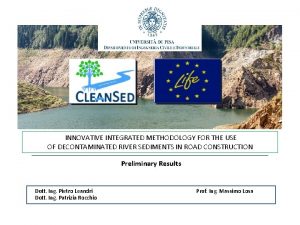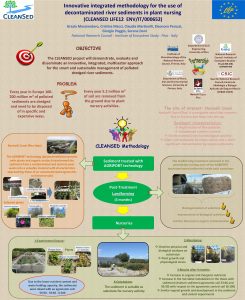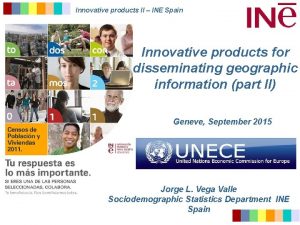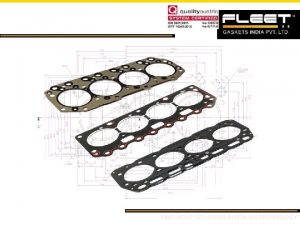CLEANSED LIFE 12 ENVIT000652 INNOVATIVE INTEGRATED METHODOLOGY FOR






























- Slides: 30

“CLEANSED LIFE 12 ENV/IT/000652” INNOVATIVE INTEGRATED METHODOLOGY FOR THE USE OF DECONTAMINATED RIVER SEDIMENTS IN ROAD CONSTRUCTION Progress Meeting Pisa, February 25 th 2016

CLEANSED - LIFE 12 ENV/IT/000652 “Innovative integrated methodology for the use of decontaminated river sediments in plant nursing and road construction” B. Implementation actions ACTIONS ACTION B. 1: Dredging, analysis and characterization of contaminated sediments Specific technical goals : -Laboratory characterization of sediments with the aim to identifying the most suitable position in the Navicelli canal where the material can be dredged in order to make the project more representative - Dredging, storage in a confined area of the dredged sediments, sampling in different locations of the storage area, handling and laboratory tests ACTION B. 4: Demonstration of the use of decontaminated sediments in road construction Specific technical goals : - Preliminary assessment of the optimum percentages of treated sediments to be used in different parts of a road construction (foundations, intermediate layer, etc) - Design of the experimental road section - Road construction (2014) C. Monitoring of the impact of the project actions ACTION C. 3: Monitoring and validation of the use of decontaminated sediments for road construction ACTION C. 4: Life Cycle Assessment - LCA Pisa- February 25 th, 2016

CLEANSED - LIFE 12 ENV/IT/000652 “Innovative integrated methodology for the use of decontaminated river sediments in plant nursing and road construction” ACTION B. 1: Dredging, analysis and characterization of contaminated sediments Sampling and laboratory characterization 1 st step: Dredging sites individuation 2 nd step: Storage of sediments in a confined area Pisa- February 25 th, 2016

CLEANSED - LIFE 12 ENV/IT/000652 “Innovative integrated methodology for the use of decontaminated river sediments in plant nursing and road construction” ACTION B. 1 1 st. Step : Characterization of sediment samples from the “Navicelli Canal” for the selection of the dredging site • UNI CEN ISO/TS 17892 -1: Water content of a soil; • CNR UNI 10006: 2002: Classification of soil; • UNI CEN ISO/TS 17892 -12: Soil texture limits; • UNI EN 1744 -1: 2010: Presence of organic components; Results: Sample ID particle size distribution 1 2 3 4 % pass 2. 0 mm 96. 6 91. 5 93. 5 86. 5 % pass 0. 4 mm 90. 8 84 86. 5 68. 6 % pass 0. 075 mm 87. 6 65. 3 30. 4 13. 1 54 29 25 17 42 26 16 9 27 15 12 0 26 0 A 7 -6 A 2 -6 A 2 -4 Yes No No LL LP Plasticity PI Group Index GI Soil classification CNR UNI 10006 Presence of organic components (UNI EN 1744 -1) Pisa- February 25 th, 2016

CLEANSED - LIFE 12 ENV/IT/000652 “Innovative integrated methodology for the use of decontaminated river sediments in plant nursing and road construction” ACTION B. 1 2 nd. Step : Characterization of stored contaminated sediments • UNI CEN ISO/TS 17892 -1: Water content of soil; • CNR UNI 10006: 2002: Classification of soil; • UNI CEN ISO/TS 17892 -12: Soil texture limits; • UNI EN 1744 -1: 2010: Presence of organic components; • % of organic components Results: Sample ID particle size distribution Plasticity 1 2 3 4 5 % pass 2. 0 mm 98. 1 98. 3 98. 4 99. 5 96. 4 % pass 0. 4 mm 96. 4 95. 7 94. 8 98. 1 88. 8 78 71 56. 7 78. 4 38. 3 43 24 19 12 40 22 18 10 36 23 13 6 42 27 15 10 29 18 11 1 A 7 -6 A 6 Yes Yes Yes 4. 08 3. 32 2. 49 3. 90 2. 00 % pass 0. 075 mm LL LP PI GI Group Index Soil classification CNR UNI 10006 Presence of organic components (UNI EN 1744 -1) Organic components content [%] Pisa- February 25 th, 2016

CLEANSED - LIFE 12 ENV/IT/000652 “Innovative integrated methodology for the use of decontaminated river sediments in plant nursing and road construction” ACTION B. 1: CONCLUSIONS – Samples 1, 2 and 4 contain high percentages of organic components (usability threshold < 5%). These samples are classified in the A 7 -6 group, that represents the highly plastic clay. They cannot be used in road constructions because they are water sensitive materials. – Samples 3 and 5 are classified in the A 6 group and contain high percentages of organic components. The typical material of this group is a plastic clay soil, 75% or more of which usually passes the 75 µm. Materials of this group usually have high volume change between wet and dry states and they can be used in embankment construction after treatment, but cannot be used in construction of subgrade layers. Because of the high organic content, a specific study is needed to assess to potential to be stabilized by using lime. ACTION B. 4 Pisa- February 25 th, 2016

CLEANSED - LIFE 12 ENV/IT/000652 “Innovative integrated methodology for the use of decontaminated river sediments in plant nursing and road construction” ACTION B. 4: Preliminary assessment of the optimum percentages of use of the treated sediments 1. LAB STUDY: Preliminary assessment of the optimum percentages of treated sediments • • • Stabilization of sediments with lime PURPOSES: • Changing the behavior of the base material • Stabilization for poor soils EFFECTS: • Variation of the natural water content (wn): Ca. O + H 2 O = Ca (OH) 2 + 15. 5 kcal • Modifications of the geotechnical characteristics of the sediments in terms of water sensitivity Determination of the Proctor compaction curve: relationship between the water content and the dry density of mixtures after compaction in standard test conditions It allows to estimating the mixture density that can be achieved in situ. Determination of the CBR Index: to characterize the bearing capacity of soil mixtures, determined immediately after compaction and after a period of curing in water 2. EXECUTIVE DESIGN OF THE DEMONSTRATION ROAD SECTION 3. ROAD CONSTRUCTION Pisa- February 25 th, 2016

CLEANSED - LIFE 12 ENV/IT/000652 “Innovative integrated methodology for the use of decontaminated river sediments in plant nursing and road construction” ACTION B. 4: LAB STUDY Stabilization of sediments with lime 1. 2. Lime proportion requirement for soil stabilization 12, 80 60 Liquid Limit, Plastic Limit 12, 70 12, 60 p. H ref p. H Plastic Index variation (with %Ca. O) 12, 50 12, 40 12, 30 Plastic limit 50 40 P PI= const 30 20 10 12, 20 0, 0 2, 0 4, 0 % Ca. O 5. 2% 6, 0 8, 0 0 0% Pisa- February 25 th, 2016 2% 4% 5. 2% 6% % Ca. O 8%

CLEANSED - LIFE 12 ENV/IT/000652 “Innovative integrated methodology for the use of decontaminated river sediments in plant nursing and road construction” ACTION B. 4: LAB STUDY Proctor curve Optimum water content Proctor curves Pisa- February 25 th, 2016

CLEANSED - LIFE 12 ENV/IT/000652 “Innovative integrated methodology for the use of decontaminated river sediments in plant nursing and road construction” ACTION B. 4 Treatment of the dredged sediments Main problem: excess of water content (dredged sediments cannot be compacted to ensure appropriate bearing capacity). It is necessary to reduce the water content at least up to 15 -20%. In situ procedure: 30 cm layer was laid on a draining material and rehashed mechanically in order to allow the air-drying. Laboratory procedure: realization of dewatering system for moisture control The sediment samples were tested periodically to check the variation of water content as a consequence of natural drying in order to assess the amount of water that the system naturally loses by evaporation and / or drainage. reproduced in a reduced scale: Environmental temperature and moisture conditions: Ø no rain and/or direct radiation Ø almost constant temperature (20°C) Field conditions : Ø lower drainage Ø lateral confinement Ø surface aeration Pisa- February 25 th, 2016

CLEANSED - LIFE 12 ENV/IT/000652 “Innovative integrated methodology for the use of decontaminated river sediments in plant nursing and road construction” ACTION B. 4 Treatment of the dredged sediments Dewatering system for moisture control TOP MIDDLE BOTTOM Pisa- February 25 th, 2016

CLEANSED - LIFE 12 ENV/IT/000652 “Innovative integrated methodology for the use of decontaminated river sediments in plant nursing and road construction” ACTION B. 4 Treatment of the dredged sediments Dewatering system for moisture control: Results In controlled environmental conditions, the moisture content can be reduced up to 40% after a period of 7 -8 weeks Pisa- February 25 th, 2016

CLEANSED - LIFE 12 ENV/IT/000652 “Innovative integrated methodology for the use of decontaminated river sediments in plant nursing and road construction” ACTION B. 4 Treatment of the dredged sediments Dewatering system for moisture control: Results Remarkable difference between the in situ and laboratory processes: Ø in situ environmental conditions cannot be controlled Ø similarly to the laboratory process, after dewatering the sediments showed a water content of about 40 % after 5 -6 weeks. the level is still too high to allow the sediments workability in order to reduce the water content and the dewatering process time, the partially dewatered sediments were mixed with lime Lime hydration process decreases the soil moisture content. Ca. O + H 2 O = Ca (OH) 2 + 15. 5 kcal The reaction is exothermic and heat generated from this chemical reaction further dries wet sediments by driving it off as steam. Pisa- February 25 th, 2016

CLEANSED - LIFE 12 ENV/IT/000652 “Innovative integrated methodology for the use of decontaminated river sediments in plant nursing and road construction” ACTION B. 4 Treatment of the dredged sediments In order to reduce the water content up to the level required for compaction, dredged sediments were mixed in laboratory with different lime percentages and the related water loss was evaluated. Pisa- February 25 th, 2016

CLEANSED - LIFE 12 ENV/IT/000652 “Innovative integrated methodology for the use of decontaminated river sediments in plant nursing and road construction” ACTION B. 4 Treatment of the dredged sediments Lab stabilization results: %Ca. O versus water content The optimum water content of about 20%, determined by the Proctor compaction curve was obtained by using a lime percentage greater than 15%. Pisa- February 25 th, 2016

CLEANSED - LIFE 12 ENV/IT/000652 “Innovative integrated methodology for the use of decontaminated river sediments in plant nursing and road construction” ACTION B. 4 Executive design of demonstration road Dredged sediments stabilized with lime Navicelli Canal 1. 2. 3. 4. 5. 6. 7. 8. Asphalt concrete (Binder course) th=10 cm Granular Subbase th=20 cm Natural soil th=50 cm Subgrade layer made of soils classified in the groups A 1 -a, A 1 -b, A 2 -4 (CNR-UNI 10006/2002) th=30 cm Fill material : dredged sediments stabilized with lime Sand bedding th=30 cm HDPE Geomembrane th=2 mm Extensometer system for measuring settlements at various depths in embankment layers Pisa- February 25 th, 2016

CLEANSED - LIFE 12 ENV/IT/000652 “Innovative integrated methodology for the use of decontaminated river sediments in plant nursing and road construction” ACTION B. 4 Executive design of demonstration road GENERAL PLAN Pisa- February 25 th, 2016

CLEANSED - LIFE 12 ENV/IT/000652 “Innovative integrated methodology for the use of decontaminated river sediments in plant nursing and road construction” ACTION B. 4 Executive design of demonstration road Pisa- February 25 th, 2016

CLEANSED - LIFE 12 ENV/IT/000652 “Innovative integrated methodology for the use of decontaminated river sediments in plant nursing and road construction” ACTION B. 4 Conclusion : Road construction in order to reduce the water content up to a value close to the Proctor moisture optimum level (19%), the lime percentage required for the stabilization (5. 2%) is increased up to 15%. Pisa- February 25 th, 2016

CLEANSED - LIFE 12 ENV/IT/000652 “Innovative integrated methodology for the use of decontaminated river sediments in plant nursing and road construction” ACTION B. 4 Conclusion : Road construction Pisa- February 25 th, 2016

CLEANSED - LIFE 12 ENV/IT/000652 “Innovative integrated methodology for the use of decontaminated river sediments in plant nursing and road construction” ACTION B. 4 Completed with road construction Pisa- February 25 th, 2016

CLEANSED - LIFE 12 ENV/IT/000652 “Innovative integrated methodology for the use of decontaminated river sediments in plant nursing and road construction” ACTION C. 3 1 st. Step : Field investigation during construction Each layer was laid only after the situ performance check of the layer to be covered. The following parameters were monitored in situ: Ø moisture content of dredged sediments stabilized with lime (BS 6576); Ø field density of dredged sediments stabilized with lime was measured after compaction by the sand-cone apparatus (CNR BU n. 22/72); Ø elastic Modulus of compacted layers by using the static and dynamic plate load tests (B. U. C. N. R. n. 146/1992, ASTM E 2835– 11; ASTM E 2583– 07 (2011) ); this parameter is a good indicator of the bearing capacity of the embankment; Ø In-situ and laboratory CBR index (ASTM D 6951 -03, UNI EN 13286 -47: 2012 ); Ø full characterization of the asphalt mix (volumetric and mechanical characteristics) Pisa- February 25 th, 2016

CLEANSED - LIFE 12 ENV/IT/000652 “Innovative integrated methodology for the use of decontaminated river sediments in plant nursing and road construction” ACTION C. 3 1 st. Step : Field investigation during construction Dynamic load plate test Field density Static load plate test Dynamic Cone Penetrometer (DCP) test - CBR in situ test In situ tests on asphalt binder mixture by using a Mobile Laboratory Pisa- February 25 th, 2016

CLEANSED - LIFE 12 ENV/IT/000652 “Innovative integrated methodology for the use of decontaminated river sediments in plant nursing and road construction” ACTION C. 3 1 st. Step : Lab investigation Evaluation of rutting resistance of asphalt pavement Rutting: a permanent deformation on the pavement surface produced by vehicle loads Before After Pisa- February 25 th, 2016

CLEANSED - LIFE 12 ENV/IT/000652 “Innovative integrated methodology for the use of decontaminated river sediments in plant nursing and road construction” ACTION C. 3 1 st. Step : Lab investigation Fatigue resistance evaluation Pisa- February 25 th, 2016

CLEANSED - LIFE 12 ENV/IT/000652 “Innovative integrated methodology for the use of decontaminated river sediments in plant nursing and road construction” ACTION C. 3 2 nd Step : Field investigation under working conditions The monitoring activities will be completed through the measurement of settlements over time in order to evaluate the behavior of the embankment under working conditions (traffic loads) Pisa- February 25 th, 2016

CLEANSED - LIFE 12 ENV/IT/000652 “Innovative integrated methodology for the use of decontaminated river sediments in plant nursing and road construction” ACTION C. 3 2 nd Step : Field investigation under working conditions Ruth depht evaluation by the use of a laser profilometer Pisa- February 25 th, 2016

CLEANSED - LIFE 12 ENV/IT/000652 “Innovative integrated methodology for the use of decontaminated river sediments in plant nursing and road construction” ACTION C. 3 2 nd Step : Field investigation under working conditions In order to evaluate the behavior of the embankment under working conditions, a magnetic extensometer system for monitoring settlements over time was installed Installation of extensometer system during construction Pisa- February 25 th, 2016

CLEANSED - LIFE 12 ENV/IT/000652 “Innovative integrated methodology for the use of decontaminated river sediments in plant nursing and road construction” ACTION C. 3 Settlements monitoring Sounding manhole The monitoring activities are being completed with the measurement of settlements over time in order to evaluate the behavior of the embankment under working conditions (traffic loads) Pisa- February 25 th, 2016

CLEANSED - LIFE 12 ENV/IT/000652 “Innovative integrated methodology for the use of decontaminated river sediments in plant nursing and road construction” ACTION C. 4 Life Cycle Assessment- LCA Monitoring the impact of the project actions Pisa- February 25 th, 2016
 Siklus hidup produk sunlight
Siklus hidup produk sunlight Fspos
Fspos Novell typiska drag
Novell typiska drag Nationell inriktning för artificiell intelligens
Nationell inriktning för artificiell intelligens Vad står k.r.å.k.a.n för
Vad står k.r.å.k.a.n för Shingelfrisyren
Shingelfrisyren En lathund för arbete med kontinuitetshantering
En lathund för arbete med kontinuitetshantering Adressändring ideell förening
Adressändring ideell förening Tidböcker
Tidböcker A gastrica
A gastrica Densitet vatten
Densitet vatten Datorkunskap för nybörjare
Datorkunskap för nybörjare Tack för att ni lyssnade bild
Tack för att ni lyssnade bild Debattartikel mall
Debattartikel mall Delegerande ledarstil
Delegerande ledarstil Nyckelkompetenser för livslångt lärande
Nyckelkompetenser för livslångt lärande Påbyggnader för flakfordon
Påbyggnader för flakfordon Arkimedes princip formel
Arkimedes princip formel Svenskt ramverk för digital samverkan
Svenskt ramverk för digital samverkan Urban torhamn
Urban torhamn Presentera för publik crossboss
Presentera för publik crossboss Vad är ett minoritetsspråk
Vad är ett minoritetsspråk Bat mitza
Bat mitza Treserva lathund
Treserva lathund Fimbrietratt
Fimbrietratt Bästa kameran för astrofoto
Bästa kameran för astrofoto Centrum för kunskap och säkerhet
Centrum för kunskap och säkerhet Verifikationsplan
Verifikationsplan Mat för idrottare
Mat för idrottare Verktyg för automatisering av utbetalningar
Verktyg för automatisering av utbetalningar Rutin för avvikelsehantering
Rutin för avvikelsehantering
































